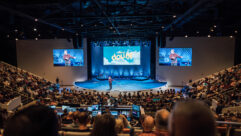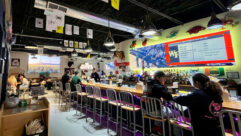
One Install, Two Events
For Peter Wille, St. Louis’ Scottrade Center is familiar ground when it comes to producing events.
CHALLENGE: Produce two live events, each using a 40-foot by 17-foot rear-projection screen with seamless two- projector overlap, high-definition, and custom resolutions.
SOLUTION: Electronic signal alignment using next-generation scaling and video-signal processing technology.
For Peter Wille, St. Louis’ Scottrade Center is familiar ground when it comes to producing events. But the September 2006 Lutheran Foundation of St. Louis’ “Two Decades of Grantmaking” event held a few twists for Wille, manager of visual technologies at St. Louis AV integrated solutions provider Cignal Systems.
“When we started our planning, we had envisioned a simple presentation, with maybe video and music,” says Melinda McAliney, grants administrator for the Lutheran Foundation. “Once Peter and his staff at Cignal came on board, the vision for the event changed, and became much more rewarding and complimentary to the foundation’s mission and goals for the day.”
One big challenge was the 40-foot by 17-foot screen that would serve as the backdrop for two hours of mostly live performances. “Originally, they were going to go with two screens, sort of the standard look that everybody does,” says Wille. “Instead, we proposed that they go with a wide screen with a two-project overlap. They thought it was a great idea. It unified the stage and made it much more impressive, because it became the backdrop for the whole stage.”
Delivering that look took a lot of preparation. As part of producing the event, Cignal shot high-definition video and whittled it down to two hours. The video was shot in 1080p, intended to be displayed at an unusual 40×17 aspect ratio as dictated by that large, single screen. The footage then was fed into Renewed Vision’s ProVideoPlayer, which Wille chose because it had the needed flexibility to accommodate the custom display requirements.
“We played everything off of that because I could use customize resolutions,” says Wille. “Everything was running at native pixel level. I was using DDC HD pro codec, but I was editing a very weird pixel size. ProVideoPlayer let me play back at that weird size.”
A 40-foot by 17-foot screen sets the stage for “Two Decades of Grantmaking,” an event of the Lutheran Foundation of St. Louis in September 2006. Cignal Systems proposed using the huge video screen, and employed the latest scaling and video-signal technology for the event.
Wille also liked the ProVideoPlayer’s price tag: $999 for the high-def version. “Those abilities are available with other products, but not at this cost,” he says. “This is a affordable video server that let me do custom resolutions in the codec I wanted to use.”
Cignal used multiple cameras for the event. One was a Panasonic P2 series camcorder that stores to a flash memory card.”I really, really like the picture from the Panasonic P2,” says Wille. “I also like all of the resolution choices I can get out of it. But the memory cards are a challenge. I have to treat them like I treat film: You can shoot only seven-minute loads. It’s not the end of the world having to do that, but we’re constantly having to download to laptops.”
Another was a JVC HD 110. “It’s a nice camera and gives me a good picture,” says Wille. “And it still records to tape, which is very nice.”
During the event, Wille picked cameras based on the required shooting styles. “If it’s much more controlled and I’m shooting film style, I’ll choose the Panasonic,” he says. “If it’s more run and gun and I’ve got to have longer loads, I’ll choose the Sony.”
Seams Are a No-Show
Another challenge at the Lutheran Foundation event was lining up the two Eiki 10,000-lumen projectors just right, so that they would create a single, seamless image. That’s no small task when the projectors are 30 feet above the stage.
WORKING WITH A 40X17 SCREEN
For the Lutheran Foundation and Maynard Ferguson events, Cignal Systems custom built a 40-foot by 17-foot rear-projection screen to serve as an eye-catching backdrop.
“We built the frame with a lighting truss, and we stretched a grommeted fabric that we got from Harkness Screens,” says Peter Wille, manager of visual technologies at Cignal. “It works quite well. We bought three more sizes from them.”
In Wille’s experience, lighting is key to making jumbo displays look good. “You’ve got to be really good friends with the lighting designer,” he says. “That’s truly the major challenge. The lighting designer can kill it or make it work, because it’s how you keep the light off of the screen, where you build your gutters, how you light it, and what colors you’re doing.”
An advantage Wille had for the two events, and others, is that his lighting designer comes from Cignal’s sister company, Logic Systems Sound and Lighting. As a result, getting on the same page involves simply walking down the hall rather than trying to schedule a meeting or call with another company. “We can work out the details before we hit the location,” he says.
Wille also believes that the truss locations should dictate where the display is located in order to optimize the viewing experience.
“We often position the screen based on where our lighting trusses are,” says Wille. “That’s key to making it work.”
“We’re often flying projectors like we’re flying trusses,” says Wille. “We do the math and get them darn close, but to nudge the projector to get the overlap to line up is very physically difficult.”
To keep the seam from showing, Wille chose TV One’s CORIO C2-7200 Dual Channel HD-SDI Video Processor, with two units handling edge blending and a third switching sources. A single TV One CC-300 hardware controller, which lists for $2,950, commanded the trio of C2-7200s.
“What I really like about the TV One product is that I can nudge the image at the pixel level up, down, left, or right,” says Wille. “Even when it’s 30 feet in the air, I can align my projectors by [electronically] nudging it with the controller. You can get an absolutely perfect alignment by nudging each image individually.”
The 7200 includes TV One’s proprietary scaling engine, which is a rarity. “Most video scaler manufacturers don’t have their own scaling engine,” said Dan Gibson, vice president of TV One in Erlanger, Ky. “They use a third-party chipset, which limits what they can do.”
The 7200 — of which Cignal was the first to use for a live event — also features a firmware-heavy design. As a result, the unit’s hardware is less of a factor in determining which types of signals it can accept and output. That’s one reason why it was attractive to Cignal for the Lutheran Foundation event and its unusual display requirements. For example, the 7200 can handle any resolution within a range of 30×30 to 2048×2048. It lists for $10,500 with high-def SDI and $7,900 without.
“If it’s an odd resolution, which we often come across in medical and government applications and in LED displays, if it’s not already in the table, we can program the resolution into the unit,” says Gibson. “I’m not aware of any video processor that can do that. We get a lot of business as a result.”
The emphasis on firmware over hardware also lets the 7200 be upgraded in the field, such as to improve its edge-blending and motion-compensation abilities as TV One enhances them. “It helps futureproof the unit,” says Gibson.
The 7200’s flexibility was particularly handy because the Lutheran Foundation’s schedule didn’t allow much time for tinkering. Cignal got access to Scottrade Center midafternoon the previous day. The mostly amateur performers began rehearsing at 7 a.m. the following morning, and didn’t stop until about five minutes before the doors opened for the 3 p.m. performance, which was attended by about 7,500. Despite the tight schedule, limited budget ($60,000 for lighting, sound, and video production) and the Lutheran Foundation’s negative experiences with the 664,000-square-foot Scottrade Center, the event went smoothly.
“Probably the biggest challenge was they really wanted a major ‘wow’ factor, but their budget wasn’t that large,” says Wille. “Plus, they’d had really bad experiences in that venue before. This client made it clear that people should be able to see, be able to hear and be impressed. That’s what we delivered.”
McAliney of the foundation says rave reviews still come in, eight months after the event, from those who attended and were impressed. “Peter and his team did an excellent job in listening to the foundation’s vision for the event, and then creating a presentation that went above and beyond our wildest expectations,” she says.
Others were impressed as well: Cignal’s work on the event won the International Special Events Society St. Louis Chapter’s award for best show with a budget of more than $20,000.
Two Weeks’ Notice
Ten days after the Lutheran Foundation event, Cignal used the same projection setup across town for a tribute to trumpeter Maynard Ferguson, who died Aug. 23, 2006. Held at the Blanche M. Touhill Performing Arts Center, the event was a scramble for Cignal, which had less than two weeks to prepare.
FOR MORE INFORMATION
Eikiwww.eiki.com
Harkness Screenswww.harkness-screens.us
JVCwww.jvc.com
Panasonicwww.panasonic.com
Renewed Visionwww.renewedvision.com
TV Onewww.tvone.com
“We had no lead time and no rehearsal,” says Wille. “Because of that, it was really important that we could deal with [such things as] changing speed as we went along or loop very quickly, and pretty much run everything on the fly.”
The concert featured top trumpet players from around the world, with screen backdrop displaying photos of Ferguson from the time when each song became famous. The screen also ran recorded tributes from jazz musicians who couldn’t attend.
The event had to go flawlessly, not only in order to provide a good show, but also because Cignal was recording it in high definition for a tribute DVD to be released by Contemporary Productions, the event’s host. For example, the event had to be video friendly in terms of lighting and the 40×17 display backdrop. (Cignal’s sister company, Logic Systems Sound and Lighting, provided support, including audio recording.)
“It was a heck of a project in terms of all the different variables,” says Wille. “Just the rendering time of the high-definition stuff we were doing in there was four days. Getting that done in their time period was an interesting challenge.”
Tim Kridel is a freelance writer and analyst who covers telecom and technology. He’s based in Columbia, Mo., and can be reached at [email protected].









